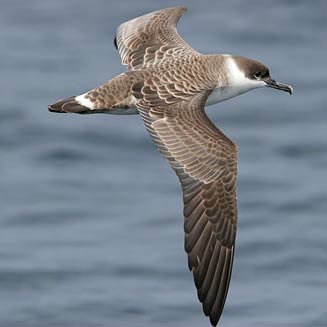Tristan da Cunha in the South Atlantic, one of the world’s smallest communities, forms part of a United Kingdom Overseas Territory. The major source of the island group’s income is from fishing, primarily inshore for Tristan Crayfish or Rock Lobster Jasus paulensis within its 12-nautical mile territorial waters. In addition a single vessel, the MFV Edinburgh, currently undertakes demersal longlining, including over seamounts, within Tristan’s 200-nautical mile Exclusive Economic Zone (EEZ) which covers 750 000 square kilometres. The resource targeted is deep-water Antarctic or Southern Butterfish Hyperoglyphe antarctica (known in Tristan waters as “Bluefish”), a species – under several other common names - that is caught by similar fisheries in Australian and New Zealand waters.
Tristan da Cunha (made up of the main island of Tristan and the outlying islands of Gough, Inaccessible and Nightingale) supports large numbers of breeding seabirds, including six ACAP-listed species, which forage within the EEZ, as well as farther afield. Of these six ACAP species, three albatrosses are considered to be globally threatened: Tristan Diomedea dabbenena (Critically Endangered), Atlantic Yellow-nosed Thalassarche chlororhynchos (Endangered) and Sooty Phoebetria fusca (Endangered). The Spectacled Petrel Procellaria conspicillata, endemic to Inaccessible Island, is Vulnerable, The Grey Petrel P. cinerea is Near Threatened and the Southern Giant Petrel Macronectes giganteus is categorized as Least Concern. All these species are at a greater or lesser risk of being caught on longlines and may be seen around the Tristan fishing vessel during line hauling and waste discarding.
In order to prevent bycatch of these ACAP species, as well as of other seabirds, the Tristan Fisheries Department (TFD) in its demersal longline fishery has followed ACAP’s best-practice guidelines, employing the mitigation measures of paired bird-scaring lines, line weighting and night setting. In addition, defrosted bait is used to help hooks sink more quickly, deck lighting is minimised with downward-directed lights during setting, and discarding takes place in batches on the opposite side of the vessel to the hauling bay; all listed as responsible practices by ACAP. Tristan Fishery Officers acting as observers aboard ensure these measures are carried out and also collect information on seabird interactions with the fishing operation.

Downward-directed lights at night on the FMV Edinburgh, photograph by Oli Yates
Shortly before the end of their summer breeding season, Great Shearwaters Ardenna gravis (which breed in huge numbers on the outlying Tristan Islands) have been observed to forage aggressively in ‘frenzies” in order to build up reserves for their trans-equatorial migration. Even with the suite of mitigation measures listed above, the deep-diving ability of the shearwaters means they can still access baited hooks, leading to incidental mortality. Following advice received from the UK’s Centre for the Environment, Fisheries and Aquaculture Science (CEFAS) a seasonal closure of longline fishing in Tristan waters from February to June has now been established to reduce mortality of Great Shearwaters. This seasonal closure should also benefit ACAP-listed albatrosses and petrels occurring in Tristan waters.

Great Shearwater
With thanks to Laura Beasley, Royal Society for the Protection of Birds, Anton Wolfaardt, Co-convenor, ACAP Seabird Bycatch Working Group and Oli Yates, CEFAS.
John Cooper, ACAP Information Officer, 14 December 2018

 English
English  Français
Français  Español
Español